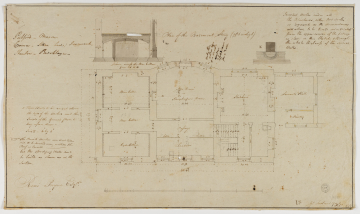
Browse
Reference number
Purpose
Aspect
Scale
Inscribed
rooms labelled: Cyder Cellar, Beer Cellar, Wine Cellar, Larder, Passage, Store Room / or / Housekeepers Room, Kitchen, Servants Hall, Scullery, stairs numbered and dimensions given; Section across the Wine Cellar / from A to B, detail for inverted arch labelled K with note (by Soane ?): Inverted Arches under all / the Apertures either either Semi circles / or Segments as the circumstances / will allow, to be turned immediately / from the upper courses of the footing / as shewn in this Sketch & through / the whole thickness of the several / Walls, C These walls to be raised above / the tops of the arches and the / Joists of the Ground floor to / lay upon them, Joists - 6" by 3" // (Walter Payne's hand ?) -with pointing finger - The Brick Arches over Wine Cellar / not to be turned over untill the / Roof is covered / but the Springing Walls must / be built as shewn in the / Section, (Soane) Putford - Mason / Co--er [Conner?] - Stone, lime, Ironwork / Shenton - Bricklayer, (Soane) under this / window leave / a cicrular / aperture / 1 foot Diam[eter] / for a drain
Signed and dated
- February 1793
IS Gt Scotland Yard Feby 1793
Medium and dimensions
Hand
Soane office
Level
Sir John Soane's collection includes some 30,000 architectural, design and topographical drawings which is a very important resource for scholars worldwide. His was the first architect’s collection to attempt to preserve the best in design for the architectural profession in the future, and it did so by assembling as exemplars surviving drawings by great Renaissance masters and by the leading architects in Britain in the 17th and 18th centuries and his near contemporaries such as Sir William Chambers, Robert Adam and George Dance the Younger. These drawings sit side by side with 9,000 drawings in Soane’s own hand or those of the pupils in his office, covering his early work as a student, his time in Italy and the drawings produced in the course of his architectural practice from 1780 until the 1830s.
Browse (via the vertical menu to the left) and search results for Drawings include a mixture of Concise catalogue records – drawn from an outline list of the collection – and fuller records where drawings have been catalogued in more detail (an ongoing process).

